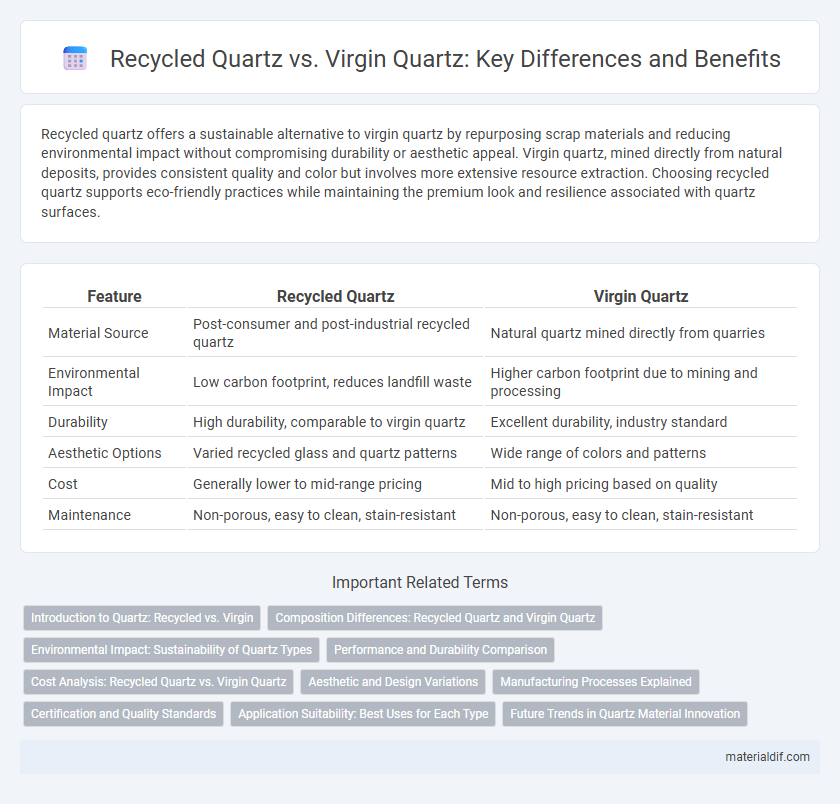Recycled quartz offers a sustainable alternative to virgin quartz by repurposing scrap materials and reducing environmental impact without compromising durability or aesthetic appeal. Virgin quartz, mined directly from natural deposits, provides consistent quality and color but involves more extensive resource extraction. Choosing recycled quartz supports eco-friendly practices while maintaining the premium look and resilience associated with quartz surfaces.
Table of Comparison
| Feature | Recycled Quartz | Virgin Quartz |
|---|---|---|
| Material Source | Post-consumer and post-industrial recycled quartz | Natural quartz mined directly from quarries |
| Environmental Impact | Low carbon footprint, reduces landfill waste | Higher carbon footprint due to mining and processing |
| Durability | High durability, comparable to virgin quartz | Excellent durability, industry standard |
| Aesthetic Options | Varied recycled glass and quartz patterns | Wide range of colors and patterns |
| Cost | Generally lower to mid-range pricing | Mid to high pricing based on quality |
| Maintenance | Non-porous, easy to clean, stain-resistant | Non-porous, easy to clean, stain-resistant |
Introduction to Quartz: Recycled vs. Virgin
Recycled quartz is manufactured by blending reclaimed quartz particles with resins and pigments, reducing environmental impact by diverting waste from landfills. Virgin quartz, mined and processed directly from natural quartz deposits, offers consistent purity and mineral composition but requires extensive extraction efforts. Both types provide durable surfaces for countertops and flooring, with recycled quartz presenting an eco-friendly alternative without compromising on strength or aesthetics.
Composition Differences: Recycled Quartz and Virgin Quartz
Recycled quartz consists primarily of reclaimed quartz particles combined with resin binders and pigments, utilizing waste from previous quartz products to reduce environmental impact. Virgin quartz is made from 90-95% natural quartz combined with polyester or epoxy resin and color pigments, ensuring consistent purity and strength. The key composition difference lies in recycled quartz's incorporation of post-consumer or post-industrial quartz fragments, whereas virgin quartz relies solely on raw mined quartz crystals.
Environmental Impact: Sustainability of Quartz Types
Recycled quartz significantly reduces environmental impact by minimizing the need for raw material extraction and decreasing landfill waste. Virgin quartz production involves extensive mining processes that contribute to habitat disruption and higher carbon emissions. Choosing recycled quartz supports sustainable practices by conserving natural resources and reducing overall energy consumption during manufacturing.
Performance and Durability Comparison
Recycled quartz offers comparable performance and durability to virgin quartz, maintaining high resistance to heat, scratching, and staining due to its engineered composition. Both materials demonstrate impressive hardness levels, typically rated around 7 on the Mohs scale, ensuring longevity in countertops and surfaces. Virgin quartz may have slightly more uniformity in appearance, but recycled quartz excels in sustainability without compromising strength or resilience.
Cost Analysis: Recycled Quartz vs. Virgin Quartz
Recycled quartz typically costs 20-40% less than virgin quartz due to lower raw material expenses and reduced processing requirements. Virgin quartz demands higher energy input and mining costs, contributing to its premium price. Long-term savings from recycled quartz also include decreased environmental impact, positively affecting lifecycle cost analysis.
Aesthetic and Design Variations
Recycled quartz surfaces offer unique aesthetic variations through embedded flecks and subtle color shifts created by repurposed materials, providing an eco-friendly alternative without sacrificing style. Virgin quartz slabs deliver consistent color and uniform patterns, ideal for sleek, modern designs requiring precise color matching and smooth finishes. Choosing between recycled and virgin quartz depends on the desired design impact, whether embracing natural imperfections or achieving flawless elegance.
Manufacturing Processes Explained
Recycled quartz is manufactured by crushing and reprocessing post-consumer or industrial quartz waste, which reduces environmental impact and conserves natural resources. Virgin quartz production involves mining raw quartz crystals, followed by extensive grinding and blending with resins or polymers to create engineered stone slabs. The recycled process incorporates sophisticated sorting and purification techniques to ensure material quality comparable to virgin quartz while promoting sustainability in surface manufacturing.
Certification and Quality Standards
Recycled quartz surfaces often hold certifications such as NSF and GREENGUARD, ensuring low emissions and environmental safety, while virgin quartz typically adheres to strict industry quality standards like ISO 9001 for manufacturing consistency. Both types of quartz undergo rigorous testing for durability, stain resistance, and non-porosity, meeting standards set by organizations such as the Natural Stone Institute and ANSI. Selecting certified quartz, whether recycled or virgin, guarantees adherence to safety, environmental, and performance benchmarks essential for sustainable building materials.
Application Suitability: Best Uses for Each Type
Recycled quartz is ideal for eco-friendly projects and low-impact applications such as countertops, flooring, and wall cladding where sustainability is prioritized without compromising durability. Virgin quartz offers superior strength and consistency, making it the best choice for high-traffic commercial spaces, laboratory surfaces, and heavy-use kitchen installations requiring maximum resilience. Selecting the appropriate quartz type depends on balancing environmental benefits with performance demands specific to the intended use.
Future Trends in Quartz Material Innovation
Recycled quartz is gaining traction in the industry due to its environmental benefits and growing consumer demand for sustainable materials, leading manufacturers to invest heavily in advanced recycling technologies. Virgin quartz continues to dominate with superior purity and consistency, but emerging innovations in composite materials are narrowing the performance gap. Future trends indicate a hybrid approach, combining recycled quartz with engineered resins to create more durable, eco-friendly surfaces while maintaining high aesthetic standards.
Recycled Quartz vs Virgin Quartz Infographic

 materialdif.com
materialdif.com